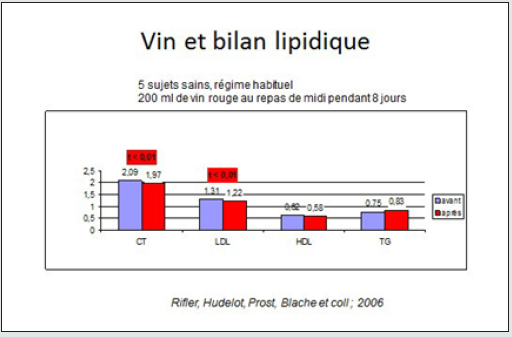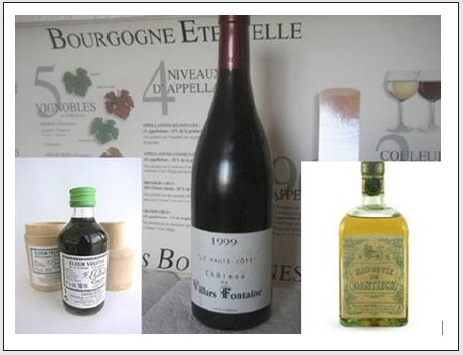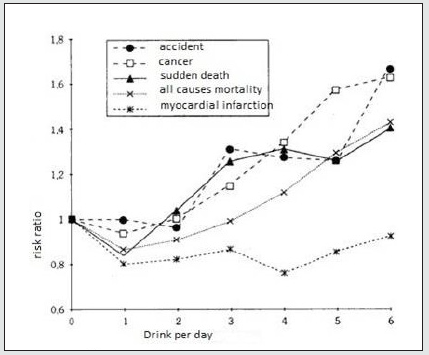
Lupine Publishers Group
Lupine Publishers
Menu
ISSN: 2641-1768
Review ArticleOpen Access
Wine and health, a whole story Volume 5 - Issue 5
Jean Pierre Rifler*
- Department of chindrens psychology, Department of Wine and Vine Components and Health, France
Received:August 30, 2021; Published:September 16, 2021
Corresponding author: Jean Pierre Rifler, Department of chindrens psychology, Department of Wine and Vine Components and Health, France
DOI: 10.32474/SJPBS.2021.05.000222
Abstract
The rule of Saint Benedict [1] was created, according to tradition, by Benedict of Nursia from 534 AC. J-C. It was adopted and disclosed following the creation of the Order of Cîteaux, in 1098, by Etienne de Harding. Bernard of Clairvaux (1090-1153 AC) will largely contribute to the dissemination of this rule which served as a model for the one he gave to the poor Children of Christ who became Templars. In rule 40: the measure of the drink; it is stated that one «hemin» of wine per day is sufficient for everyone. This hemin is an ancient Roman measure for liquids corresponding to 27 centiliters [2] that is the equivalent of the current 3 standard glasses considered acceptable daily consumption by the anti-alcoholic leagues. In fact, wine has always been part of the history of mankind, it is, according to the Bible, Noah who planted the vine after the flood. But it was with Hippocrates (460-377 BC), father of modern medicine, that wine experienced a real consecration in the therapeutic field. He said: «Wine is a wonderfully suitable thing for man if, in health as in sickness, it is administered in a proper and just manner, in accordance with the individual constitution». In his famous work published in 1866, Pasteur (1822-1895) considered wine «the healthiest and most hygienic of drinks». Recently, many studies have attempted to unmask the «French Paradox», a term used by Serge Renaud in 1991 on CBS, this French paradox consisting of low mortality from cardiovascular disease despite a high consumption of saturated fat [3].
Introduction
The epidemiological studies of Saint Léger [4] then of Keys [5] (13,000 subjects followed for 20 years (start of the study in 1952), showed that the Mediterranean basin, and more particularly Crete, was protected, probably because of a particular diet. The MONICA project [6] confirmed the special position of France and highlighted a south-north mortality gradient confirming this probable origin of the very different regime of Toulouse and Lille. Fat consumption mono and polyunsaturated, garlic, duck fat, low saturated fat diets, fruits and vegetables, has been advanced to identify the Mediterranean diet. The Cretan diet differs from the Mediterranean diet by its frugality. All these Mediterranean civilizations are also viticultural civilizations and some wanted to see in wine an important, even essential, element of this health-longevity regime, protective among other things against cardiovascular diseases. The antioxidant effect of red wine flavonoids appears to be one of the vascular protective mechanisms provided by the Mediterranean diet. Yusuf’s meta-analysis [7] shows that moderate alcohol consumption (two drinks per day) is a cardiovascular protective factor, as is the decrease in LDL levels, smoking cessation, fruit and vegetables and physical activity.
Atheromatous plaque in the coronary arteries is responsible for myocardial infarction and, in the carotid artery, it causes ischemic stroke. The mechanism of plaque formation is complex and multifactorial, but always begins with an accumulation of LDL which oxidizes in the intima of the artery. The effect of red wine on LDL oxidation could be the key to the French paradox. Indeed, the decrease in LDL (bad cholesterol) and the increase in the antioxidant power of serum are two major protective factors. If there is less LDL and they are less oxidized, they will deposit less in the arteries, thus the formation of atheromatous plaque will be delayed. The interstroke study [8] confirms these data for strokes at the dose of one drink per day. Some will take the shortcut by saying that one drink for the brain and two for the heart is the three drinks allowed per day from Saint Benedict.
But before recommending red wine as a beneficial dietary supplement, it should be noted that the dose of alcohol must remain acceptable in order not to cause the known harmful effects of ethanol. On the other hand, it is certain that, whatever the red wine, it is a soup of antioxidants which can be kept for a very long time when the vinification is carried out in a traditional way (temperature control, long maceration, aging in barrels), and easily assimilated by the body thanks to alcohol [9]. Alcohol offers superior bioavailability. It is no coincidence that wine has always been part of the diet of Mediterranean countries, it was the only way to conserve antioxidants (from plants) for the winter (Figure 1).
In an age of globalization, canning and freezing, the fact is that a glass of red wine brings many more easily absorbed antioxidants than large amounts of fruits and vegetables. (A glass of wine provides the same antioxidant effect as 20 liters of tea). The J-curve (Figure 2) represents the total mortality compared to the number of glasses of wine drink per day. In Ellison’s version [10], ischemic heart disease is isolated from other causes of death. If we find an increase in the number of deaths by accident, cancer or sudden death due to a daily consumption of more than 3 glasses, it is necessary to note an increase in cardiovascular protection beyond these doses. In addition, a 1997 study showed that it is the regular consumption of moderate doses of wine (200 ml) that provides antioxidant protection (Figure 3). In another 2006 study, a supplement of 200 ml of red wine, taken with a midday meal, in healthy volunteers, showed a decrease in total cholesterol and LDL cholesterol within one week only [11]. This regular and moderate consumption of red wine thus makes it possible to neutralize the initiating factors of atheromatous plaque, and therefore to have a protective cardiac effect in primary prevention (Figure 4).
Figure 3: 1997 study showing an increase in the antioxidant potential of serum with daily consumption of 200 ml of wine. A single wine (red number 2) shows significant immediate action, it was a wine from Domaine de la Romanée Conti.

Figure 4: Study results showing the decrease in Total Cholesterol and LDL in healthy subjects consuming 200 ml of red wine per day (11).

In secondary prevention, we demonstrated in 2012 [12], the same phenomenon in patients having suffered a myocardial infarction, 3 days after the accident, a prudent European diet was implemented. A draw designated two groups of patients, one group drank water, the other group drank red wine (2 glasses per day, Haute Côte de Nuit Villars Fontaine 1989) [13]. The wine group has the same cardiovascular protection as in primary prevention (Figure 4). And above all, wine in a moderate dose provides pleasure, the pleasure of an exchange between guests around a good meal. It is no coincidence that the French gourmet meal was listed as a UNESCO World Heritage Site in 2010. In moderate doses, wine is the best anti-anxiety medication; Allowing citizens to relax with a glass of wine, instead of making them feel guilty, would reduce the prescription of benzodiazepines and antidepressants and reduce social security deficits while eliminating the side effects of these dangerous drugs. Only abuse is dangerous and Sometimes worshiped, sometimes demonized, it is certain that the tasting ritual is important. Symposion for the Romans, French meal supported by Unesco. Everything goes through education.
Conclusion
Let’s drink less, but drink better, to live older.
References
- La règle de saint Benoit, Tomes I et II (1972) Adalbert de Vogüé, texte établi et présenté par Jean Neufville, collection Sources chrétiennes, É du Cerf pp: 181-182.
- Smith, Sir William, Charles Anthon (1851) A new classical dictionary of Greek and Roman biography, mythology, and geography partly based upon the Dictionary of Greek. New York, Harper & Bros pp : 1024-1030.
- Renaud S, De Lorgeril M (1992) Wine, alcohol, platelets, and the French paradox for coronary heart disease. Lancet 339: 1523-1526.
- St Leger AS, Cochrane AL, Moore F (1979) Factors associated with cardiac mortality in developed countries with particular reference to the consumption of wine. Lancet 1(8124): 1017-1020.
- Keys A (1970) Coronary heart disease in seven countries. Circulation 41(Suppl.1): 211.
- Tunstall Pedoe H, Kuulasmaa K, Amouyel P, Arveiler D, Rajakangas AM, et al. (1994) Myocardial infarction and coronary deaths in the World Health Organization MONICA Project. Registration procedures, event rates, and case-fatality rates in 38 populations from 21 countries in four continents. Circulation 90(1): 583-612.
- Yusuf S, Hawken S, Ounpuu S, Dans T, Avezum A, et al. (2004) Effect of potentially modifiable risk factors associated with myocardial infarction in 52 countries (the INTERHEART study): case-control study. Lancet 364(9438): 937-952.
- O'Donnell MJ, Xavier D, Liu L, Zhang H, Chin SL, et al. (2010) Risk factors for ischemic and intracerebral haemorrhagic stroke in 22 countries (the INTERSTROKE study): A case-control study. The Lancet 376(9735): 112-123.
- Miyagi Y, Miwa K, Inoue H (1997) Inhibition of human low-density lipoprotein oxidation by flavonoids in red wine and grape juice. American Journal of Cardiology 80(12): 1627-1631.
- R Curtis Ellison (1990) Cheers. Epidemiology 1(5): 337-339.
- Hudelot B, Cottin Y, Blache D, Rifler JP, Corder R, et al. (2008) Tarby, Colloque Vin et Nutrition. Orateurs p. 23-25.
- Rifler JP, Lorcerie F, Durand P, Delmas D, Ragot K, et al. (2012) A moderate red wine intake improves blood lipid parameters and erythrocytes membrane fluidity in post myocardial infarct patients. Molecular Nutrition & Food Research 56(2): 345-351.
- Rifler JP (2018) Is a meal without wine good for health? Diseases 6(4): 105.

Top Editors
-

Mark E Smith
Bio chemistry
University of Texas Medical Branch, USA -

Lawrence A Presley
Department of Criminal Justice
Liberty University, USA -

Thomas W Miller
Department of Psychiatry
University of Kentucky, USA -

Gjumrakch Aliev
Department of Medicine
Gally International Biomedical Research & Consulting LLC, USA -

Christopher Bryant
Department of Urbanisation and Agricultural
Montreal university, USA -

Robert William Frare
Oral & Maxillofacial Pathology
New York University, USA -

Rudolph Modesto Navari
Gastroenterology and Hepatology
University of Alabama, UK -

Andrew Hague
Department of Medicine
Universities of Bradford, UK -

George Gregory Buttigieg
Maltese College of Obstetrics and Gynaecology, Europe -

Chen-Hsiung Yeh
Oncology
Circulogene Theranostics, England -
.png)
Emilio Bucio-Carrillo
Radiation Chemistry
National University of Mexico, USA -
.jpg)
Casey J Grenier
Analytical Chemistry
Wentworth Institute of Technology, USA -
Hany Atalah
Minimally Invasive Surgery
Mercer University school of Medicine, USA -

Abu-Hussein Muhamad
Pediatric Dentistry
University of Athens , Greece

The annual scholar awards from Lupine Publishers honor a selected number Read More...






